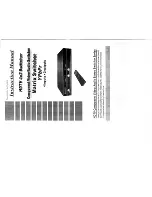
Procedure 8.14: PERFORM COMMUNICATIONS MODULE/TIME-MULTIPLEXED SWITCH
FAN ALARM TESTS
OVERVIEW
CAUTION:
Do not remove fuses to simulate fan alarms. The RESET button on the fan unit power control board is
used to simulate a fan failure that results in system alarm responses.
This procedure checks the system responses for fan alarm circuits. The test provides for the fan alarms in the
communications module (CM) and the time-multiplexed switch (TMS). The test simulates a fan failure that causes a
momentary loss of power, by depressing the power
RESET
button on the fan unit control board. The exchange
indicators (alarms, reports, and display pages) are checked to verify the proper responses.
TEST FAN UNIT ALARMS
PROCEDURE
1.
At the master control center (MCC) terminal, type and enter:
115
Response
115 - COMMUNICATION MODULE SUMMARY
page displayed (CM2)
or
115 - MSGS/TMS SUMMARY
page displayed (CM1).
2.
Select the CM cabinet to be tested.
3.
At the rear of the selected CM cabinet, open the door to access the fan unit.
4.
Visually locate the
RESET
button and red light-emitting diodes (LEDs) that indicate fan unit status.
5.
Push and hold the
RESET
button for several seconds.
Response:
The red
FAN ALARM
LED lights.
The audible MAJOR alarm sounds.
The yellow
FAN ALARM
LEDs on the top front and rear bezels light.
At the MCC terminal, the MAJOR indicator lights and the CM indicator flashes.
On 115 Page display, the
FAN ALARM
indicator associated with the CM cabinet lights.
At the receive-only printer (ROP), the
REPT ALM FAN FS CM x
report is printed.
Where:
x
= Selected CM or TMS number.
6.
Release the
RESET
button.
Response:
The red
FAN ALARM
LED goes off.
The yellow
FAN ALARM
LEDs on top front and rear bezels go off.
At the MCC terminal, the CM indicator goes off (if all CMs are operational).
At the ROP, the
REPT ALM CLR FAN CM x
report is printed.
Where:
x
= Selected CM number.
7.
At the selected
CM x
cabinet, close the rear door.
235-105-210
October 1999
Copyright © 1999
Page 1
Summary of Contents for 5ESS-2000
Page 96: ...235 105 210 October 1999 Copyright 1999 Page 2 ...
Page 184: ...235 105 210 October 1999 Copyright 1999 Page 3 ...
Page 300: ...13 STOP YOU HAVE COMPLETED THIS PROCEDURE 235 105 210 October 1999 Copyright 1999 Page 55 ...
Page 339: ...7 STOP YOU HAVE COMPLETED THIS PROCEDURE 235 105 210 October 1999 Copyright 1999 Page 13 ...
Page 342: ...235 105 210 October 1999 Copyright 1999 Page 2 ...
Page 359: ...235 105 210 October 1999 Copyright 1999 Page 5 ...
Page 609: ...2 STOP YOU HAVE COMPLETED THIS PROCEDURE 235 105 210 October 1999 Copyright 1999 Page 12 ...
Page 676: ...235 105 210 October 1999 Copyright 1999 Page 9 ...
Page 792: ...3 STOP YOU HAVE COMPLETED THIS PROCEDURE 235 105 210 October 1999 Copyright 1999 Page 9 ...
Page 799: ...Figure 11 36 3 1 Cleaning Points 235 105 210 October 1999 Copyright 1999 Page 7 ...
Page 801: ...235 105 210 October 1999 Copyright 1999 Page 9 ...
Page 839: ...2 STOP YOU HAVE COMPLETED THIS PROCEDURE 235 105 210 October 1999 Copyright 1999 Page 16 ...
Page 999: ...2 STOP YOU HAVE COMPLETED THIS PROCEDURE 235 105 210 October 1999 Copyright 1999 Page 13 ...
Page 1008: ...Figure 11 55 1 CTSNS DIP Switch Settings 235 105 210 October 1999 Copyright 1999 Page 2 ...
Page 1011: ...235 105 210 October 1999 Copyright 1999 Page 5 ...
Page 1053: ...235 105 210 October 1999 Copyright 1999 Page 15 ...
Page 1289: ...Figure 15 17 2 AMATPS Data Link 235 105 210 October 1999 Copyright 1999 Page 2 ...
Page 1292: ...235 105 210 October 1999 Copyright 1999 Page 5 ...
Page 1303: ...9 STOP YOU HAVE COMPLETED THIS PROCEDURE 235 105 210 October 1999 Copyright 1999 Page 2 ...
Page 1360: ...Figure 15 47 2 Typical SCANS III Link Diagram 235 105 210 October 1999 Copyright 1999 Page 2 ...
Page 1372: ...235 105 210 October 1999 Copyright 1999 Page 2 ...
Page 1374: ...235 105 210 October 1999 Copyright 1999 Page 4 ...
Page 1421: ...Table 1 1 O M Checklist 235 105 210 October 1999 Copyright 1999 Page 3 ...
















































